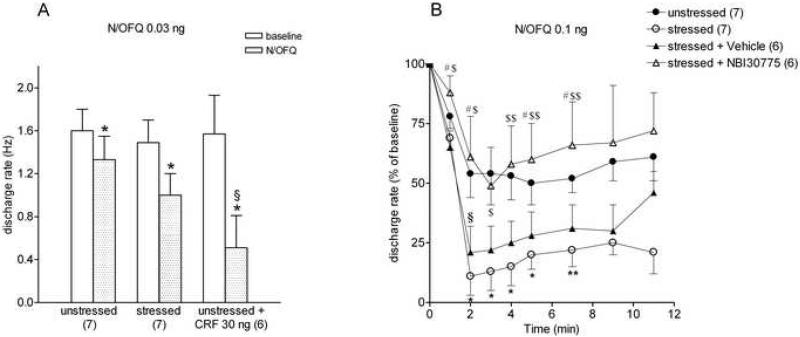Figure 3.
In vivo single unit extracellular recordings in rat dorsal raphe nucleus (DRN). A: inhibitory effect of intra-raphe infusion of 0.03 ng/30 nl Nociceptin/Orphanin FQ (N/OFQ) in unstressed rats, in rats exposed to swim stress 24 h prior to recording, in rats treated with 30 ng/30 nl oCRF 1 h prior to recording. The histograms represent the means ± s.e.m. of the discharge rates of DRN units (Hz); in parentheses the number of experiments. * P<0.05, ** P< 0.01, significantly different vs. baseline, Student's t test for paired data; § P<0.05 vs. unstressed rats, Student's t test for unpaired data. B: Time course of the effect of intra-raphe infusion of 0.1 ng/30 nl N/OFQ on DRN neuronal activity in unstressed, stressed, vehicle-injected and NBI 30755-injected stressed rats. Either the CRF1 antagonist NBI 30755 (20 mg/kg, i.p.) or its vehicle were administered 30 min prior to the swim stress. Abscissa: time after N/OFQ administration; ordinate: mean discharge rate, expressed as a percentage of the mean determined over 180 s prior to N/OFQ infusion (baseline); in parentheses the number of experiments.
Repeated-measures analysis of variance indicated a statistically significant effect of group [F(3,22) = 4.657, P= 0.0115] and time [F(5,110) = 28.740, P < 0.0001].
Symbols indicate differences determined by Fisher post hoc test:
* P < 0.05, **P <0 .01, stressed vs. unstressed;
§ P < 0.05, stressed + vehicle vs. unstressed;
$ P < 0.05, $$ P <0 .01, stressed + NBI 30775 vs. stressed;
# P < 0.05, stressed + NBI 30775 vs. stressed + vehicle.

